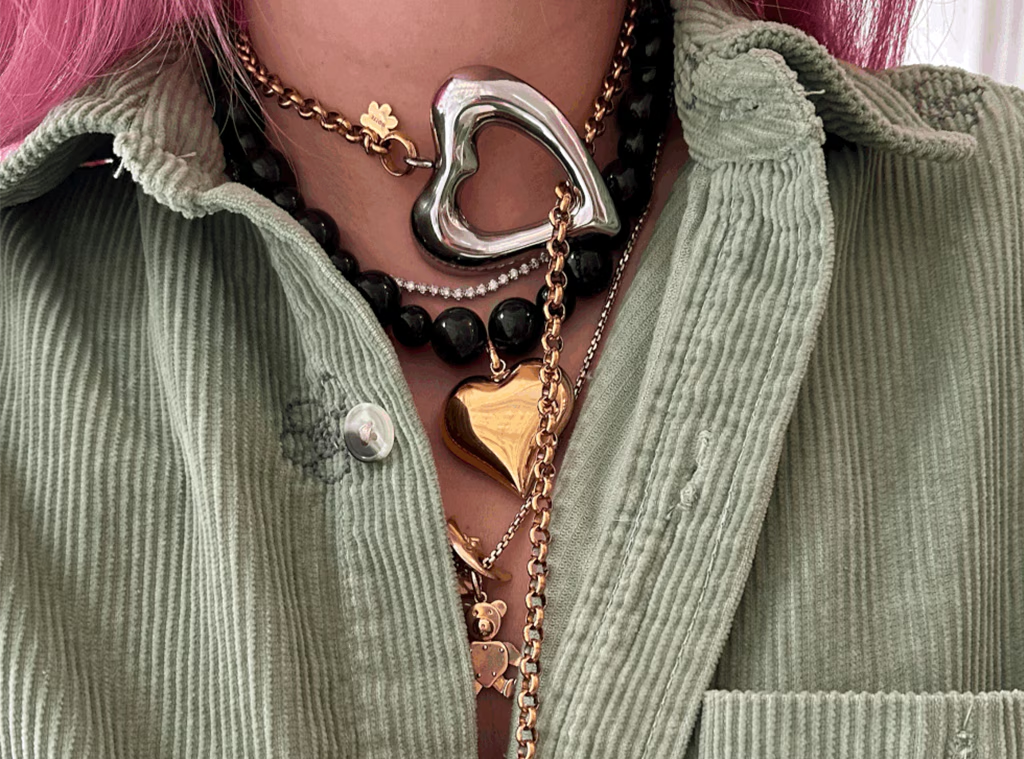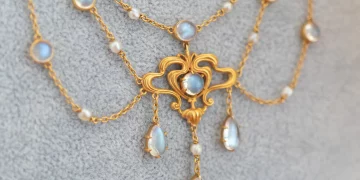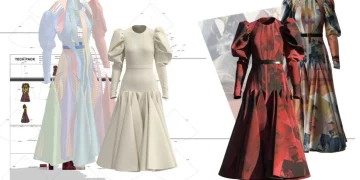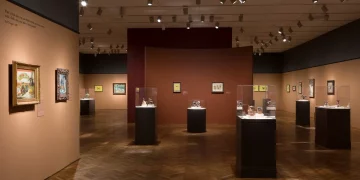Karl Lagerfeld was a creative genius who left an indelible mark on both the fashion and jewelry industries. Known for his sharp wit, unrelenting creativity, and boundary-pushing designs, Lagerfeld was more than just a designer—he was an artist in every sense of the word. His jewelry designs, much like his fashion creations, embodied his distinctive artistic philosophy, which was rooted in a deep understanding of history, craftsmanship, and modernity. Whether designing for Chanel, his own Lagerfeld brand, or as a collaborator with other luxury houses, Lagerfeld’s jewelry always carried his signature style—elegant, playful, and iconoclastic.
In this article, we’ll delve into how Karl Lagerfeld’s jewelry designs reflect his artistic philosophy. We’ll also highlight the iconic pieces that most clearly represent his design style, showing how Lagerfeld’s deep connection to culture, modernism, and personal identity translated into his jewelry creations.
1. Karl Lagerfeld’s Artistic Philosophy: Fusion of Tradition and Innovation
At the core of Lagerfeld’s approach to design was his ability to balance tradition with innovation. As a designer, Lagerfeld was both a student of history and a visionary. His work was always rooted in an appreciation of the craftsmanship and aesthetic beauty of the past, yet he had an unyielding commitment to modernizing these concepts to fit the contemporary world.
1.1 A Strong Connection to History and Culture
Lagerfeld’s deep understanding of fashion history, art, and popular culture was the backbone of his creative vision. He was constantly inspired by the classics—from ancient civilizations to the couture of the early 20th century. However, Lagerfeld was not one to simply copy or replicate the past; rather, he infused traditional elements with a fresh, contemporary twist.
- Baroque motifs, Renaissance jewelry techniques, and the elegant lines of art deco were all sources of inspiration for Lagerfeld. But he would reinterpret these styles through modern techniques and materials, ensuring that they felt relevant for the present day.
- Lagerfeld’s jewelry pieces often used historical references—such as medieval shapes, Victorian floral designs, or Greek goddess symbolism—but through sleek, minimalist forms that made the designs feel fresh and bold.
1.2 Embracing Contradictions and Irony
Lagerfeld was known for his ability to combine opposing elements—the opulent with the minimal, the classic with the avant-garde. His jewelry designs were often an exploration of contrast: mixing luxurious gemstones with industrial materials, or delicate pearls with rough-edged metals. This tension between elements created an ironic beauty in his work, a hallmark of his broader design philosophy.
- He often played with size and scale, creating jewelry that was grand and bold, but also understated in some collections, making a statement through the power of simplicity.
- His pieces were never purely decorative but rather acted as sculptural expressions, challenging what was expected in jewelry design.
2. Key Design Elements in Lagerfeld’s Jewelry
Karl Lagerfeld’s jewelry designs were always instantly recognizable for their iconic motifs, unexpected materials, and distinctive finishes. Whether crafting pieces for Chanel, his own Lagerfeld line, or collaborations with other brands, Lagerfeld’s jewelry reflected his keen interest in the fusion of art, architecture, and fashion.
2.1 Iconic Motifs: The Chanel Influence
Lagerfeld’s work with Chanel was perhaps his most significant contribution to the jewelry world, where his artistic philosophy became interwoven with the brand’s identity. Under Lagerfeld’s direction, Chanel’s jewelry evolved into a masterful combination of elegance and edge.
- Camellia flower: The camellia, one of the most iconic symbols of Chanel, became a central motif in Lagerfeld’s jewelry collections. Lagerfeld’s interpretation of the camellia was unique—he would create pieces that felt both classic and contemporary, using pearls, gold, and rhinestones to capture the flower’s feminine elegance while incorporating modern geometry and clean lines.
- Interlocking C’s: The interlocking C’s, another classic Chanel symbol, were reimagined in Lagerfeld’s collections in unexpected forms, such as pendants, bracelets, and rings, often paired with bold gemstones or metal finishes.
- Pearls: Lagerfeld used pearls not just as an element of luxury but also as an artistic expression. Often arranged in asymmetrical patterns, his pearls were transformed into sculptural forms that played with texture and movement.
2.2 Sculptural Jewelry: Bold and Modern
Lagerfeld’s fascination with sculpture was evident in many of his jewelry pieces. His designs often took on a three-dimensional, sculptural quality, pushing the boundaries of what was traditionally seen as jewelry. He approached jewelry as a form of art, where the sculptural aspect was just as important as the material.
- His geometric shapes and angular designs were often inspired by architecture, giving his jewelry a structural and modern feel. From sharp, clean lines to curved contours, Lagerfeld’s designs were a celebration of form.
- Many of Lagerfeld’s pieces felt like miniature sculptures, meant not just to be worn but to be admired as works of art in their own right. This sense of sculptural design made his jewelry particularly appealing to collectors and art enthusiasts, who saw them as more than just accessories.
2.3 Reimagining Icons: Lagerfeld’s Personal Symbols
Lagerfeld’s personal aesthetic and cultural influences played a significant role in his jewelry designs. He often incorporated personal symbols into his work—symbols that represented his own identity, artistic vision, and cultural references.
- The Cat: Lagerfeld’s famous white cat, Choupette, became an iconic motif in his designs. He created playful and whimsical pieces featuring Choupette’s likeness, from pendants to brooches, often adorned with sparkling gems and elegant finishes.
- Silhouettes and Faces: Lagerfeld’s fascination with silhouettes and portraiture translated into some of his most iconic jewelry pieces. He designed jewelry featuring profile faces, often rendered in black enamel or gold, representing modern femininity in a minimalist way.

3. Iconic Pieces That Define Lagerfeld’s Jewelry Style
Certain pieces stand out as defining examples of Lagerfeld’s jewelry design philosophy. These pieces are representative of his ability to blend modern artistry with timeless elegance, each capturing his distinctive vision of luxury and contemporary style.
3.1 The Camellia Brooches
Lagerfeld’s reimagining of the camellia flower in his Chanel jewelry collections became one of his most iconic designs. These brooches were often crafted using gold, rhinestones, and pearls, with each petal and stigma rendered in highly textured, sculptural forms. The camellia served as a symbol of femininity and grace, while Lagerfeld’s modern take on it brought a sharp, geometric edge to the classic flower.
- The bold use of contrasting materials, such as black enamel against gold, or pearls alongside rhinestones, made these brooches feel both timeless and fresh. These pieces were more than just accessories; they were wearable works of art.
3.2 The Chanel “Double C” Necklace
The interlocking C’s of Chanel’s logo have become iconic symbols of luxury and elegance. Lagerfeld took this classic motif and turned it into an oversized, sculptural necklace, featuring large, interlocking C’s set in gold or rhodium finishes, often encrusted with diamonds or rhinestones.
- The boldness of this necklace, paired with the delicate nature of the gemstones, showed Lagerfeld’s signature ability to mix femininity with modern edge, turning a simple logo into a luxurious statement piece.
3.3 The Choupette Cat Brooch
As a tribute to Lagerfeld’s beloved cat, Choupette, the designer created several jewelry pieces featuring the fluffy white cat’s likeness. One of the most iconic was a cat-shaped brooch, set with diamonds, pearls, and emeralds, capturing the playful yet sophisticated nature of both Lagerfeld’s personal style and his connection to his cat.
Conclusion: Karl Lagerfeld’s Jewelry as Art
Karl Lagerfeld’s jewelry designs are a masterclass in artistic philosophy. His work demonstrates how traditional elements can be reinterpreted and modernized, how history and modernity can be fused, and how luxury can be infused with personal meaning and cultural references. Lagerfeld’s jewelry is not just about adornment; it is about expressing individuality, telling stories, and elevating everyday beauty into the realm of high art.
Whether it’s the sculptural camellia brooches, the bold Chanel necklaces, or the playful Choupette cat designs, Lagerfeld’s pieces are more than just jewelry—they are masterpieces that reflect his artistic vision, modern sensibility, and personal touch.

















































